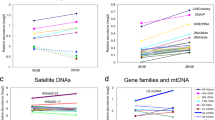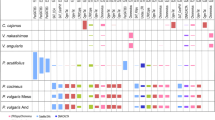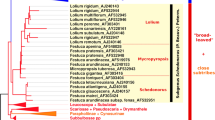Abstract
The highly repetitive DNA fraction of the eukaryotic genome is considered a mobile, rapidly changing entity, thus reflecting trajectories of short-term evolutionary change. It consists of several large classes in which transposable elements and satellite DNA (satDNA) predominate. Despite a growing awareness of its structure and functional significance, the evolutionary dynamics of repetitive elements and, particularly, satDNA remain poorly characterized. Next-generation sequencing (NGS) has opened up new possibilities for high-throughput genome analysis. Here, we applied satDNA repeatome elements derived from NGS data as probes for fluorescence in situ hybridization to characterize the karyotypes of three diploid hawkweed species of the predominantly polyploid apomictic genus Hieracium, namely H. intybaceum, H. prenanthoides and H. alpinum. Three cluster-distributed, genus-specific satDNA elements that are not present in the sister genus Pilosella were identified; notably, one element spans the functional centromeres. Each of the investigated diploids possessed a species-specific assortment of detected repeats. Their utilization as molecular-cytogenetic markers, in combination with ribosomal DNA loci, allowed for the development of a system to identify the individual chromosomes of the Hieracium species, thus providing a basis for the future investigation of karyotype evolution in diploid hawkweeds and for exploring satDNA dynamics in hybrids and apomicts of allopolyploid origin.



Similar content being viewed by others
References
Akiyama Y, Hanna WW, Ozias-Akins P (2005) High-resolution physical mapping reveals that the apospory-specific genomic region (ASGR) in Cenchrus ciliaris is located on a heterochromatic and hemizygous region of a single chromosome. Theor Appl Genet 111:1042–1051. https://doi.org/10.1007/s00122-005-0020-5
Ansorge WJ (2009) Next-generation DNA sequencing techniques. New Biotechnol 25:95–203. https://doi.org/10.1016/j.nbt.2008.12.009
Aparicio A (1994) Karyological studies in Hieracium baeticum (Asteraceae) from the “Parque Natural de la Sierra de Grazalema” (Southern Spain). Fl Medit 4:25–34
Asker SE, Jerling L (1992) Apomixis in plants. CRC Press, Boca Raton
Belyayev A (2014) Bursts of transposable elements as an evolutionary driving force. J Evol Biol 27:2573–2584. https://doi.org/10.1111/jeb.12513
Belyayev A, Raskina O, Nevo E (2001) Chromosomal distribution of reverse transcriptase containing retroelements in two Triticeae species. Chromosome Res 9:129–136
Benson G (1999) Tandem repeats finder: a program to analyze DNA sequences. Nucl Acids Res 27:573–580
Biscotti MA, Olmo E, Heslop-Harrison JS (2015) Repetitive DNA in eukaryotic genomes. Chromosome Res 23:415–420. https://doi.org/10.1007/s10577-015-9499-z
Charlesworth B, Sniegowski P, Stephan W (1994) The evolutionary dynamics of repetitive DNA in eukaryotes. Nature 371:215–220. https://doi.org/10.1038/371215a0
Chrtek J Jr, Mráz P, Severa M (2004) Chromosome numbers in selected species of Hieracium s.str. (Hieracium subgen. Hieracium) in the Western Carpathians. Preslia 76:119–139
Chrtek J Jr, Zahradníček J, Krak K, Fehrer J (2009) Genome size in Hieracium subgenus Hieracium (Asteraceae) is strongly correlated with major phylogenetic groups. Ann Bot (Oxford) 104:161–178. https://doi.org/10.1093/aob/mcp107
Dodsworth S, Chase MW, Kelly LJ, Leitch IJ, Macas J, Novák P, Piednoël M, Weiss-Schneeweiss H, Leitch AR (2015) Genomic repeat abundances contain phylogenetic signal. Syst Biol 64:112–126. https://doi.org/10.1093/sysbio/syu080
Emadzade K, Jang T-S, Macas J, Kovařík A, Novák P, Parker J, Weiss-Schneeweiss H (2014) Differential amplification of satellite PaB6 in chromosomally hypervariable Prospero autumnale complex (Hyacinthaceae). Ann Bot (Oxford) 114:1597–1608. https://doi.org/10.1093/aob/mcu178
Fehrer J, Gemeinholzer B, Chrtek J Jr, Bräutigam S (2007) Incongruent plastid and nuclear DNA phylogenies reveal ancient intergeneric hybridization in Pilosella hawkweeds (Hieracium, Cichorieae, Asteraceae). Molec Phylogen Evol 42:347–361. https://doi.org/10.1016/j.ympev.2006.07.004
Fehrer J, Krak K, Chrtek J (2009) Intra-individual polymorphism in diploid and apomictic polyploid hawkweeds (Hieracium, Lactuceae, Asteraceae): disentangling phylogenetic signal, reticulation, and noise. BMC Evol Biol 9:239. https://doi.org/10.1186/1471-2148-9-239
Ferree PM, Barbash DA (2009) Species-specific heterochromatin prevents mitotic chromosome segregation to cause hybrid lethality in Drosophila. PLoS Biol 7:e1000234. https://doi.org/10.1371/journal.pbio.1000234
Garrido-Ramos MA (2015) SatDNA in plants: more than just rubbish. Cytogenet Genome Res 146:153–170. https://doi.org/10.1159/000437008
Hall TA (1999) BioEdit: a user-friendly biological sequence alignment editor and analysis suite. Nucl Acids Symp Ser 41:95–98
Hand ML, Vít P, Krahulcová A, Johnson SD, Oelkers K, Siddons H, Chrtek J Jr, Fehrer J, Koltunow AMG (2015) Evolution of apomixis loci in Pilosella and Hieracium (Asteraceae) inferred from the conservation of apomixis-linked markers in natural and experimental populations. Heredity 114:17–26. https://doi.org/10.1038/hdy.2014.61
Hemleben V, Kovařík A, Torres-Ruiz RA, Volkov RA, Beridze T (2007) Plant highly repeated satellite DNA: molecular evolution, distribution and use for identification of hybrids. Syst Biodivers 5:277–289. https://doi.org/10.1017/S147720000700240X
Henikoff S, Ahmad K, Malik HS (2001) The centromere paradox: stable inheritance with rapidly evolving DNA. Science 293:1098–1102. https://doi.org/10.1126/science.1062939
Ilnicki T, Hasterok R, Szeląg Z (2010) Cytogenetic analysis of Hieracium transylvanicum (Asteraceae). Caryologia 63:192–196
Kamm A, Galasso I, Schmidt T, Heslop-Harrison JS (1995) Analysis of a repetitive DNA family from Arabidopsis arenosa and relationships between Arabidopsis species. Pl Molec Biol 27:853–862
Kloc A, Martienssen R (2008) RNAi, heterochromatin and the cell cycle. Trends Genet 24:511–517. https://doi.org/10.1016/j.tig.2008.08.002
Krak K, Caklová P, Chrtek J, Fehrer J (2013) Reconstruction of phylogenetic relationships in a highly reticulate group with deep coalescence and recent speciation. Heredity 110:138–151. https://doi.org/10.1038/hdy.2012.100
Lermontova I, Sandmann M, Mascher M, Schmit AC, Chabouté ME (2015) Centromeric chromatin and its dynamics in plants. Pl J 83:4–17. https://doi.org/10.1111/tpj.12875
Lima de Faría A (1980) Classification of genes, rearrangements and chromosomes according to the chromosome field. Hereditas 93:1–46
Lysak MA, Fransz PF, Ali HBM, Schubert I (2001) Chromosome painting in Arabidopsis thaliana. Pl J 28:689–697
Macas J, Kejnovský E, Neumann P, Novák P, Koblížková A, Vyskot B (2011) Next generation sequencing-based analysis of repetitive DNA in the model dioecious plant Silene latifolia. PLoS ONE 6:e27335. https://doi.org/10.1371/journal.pone.0027335
Martienssen RA (2003) Maintenance of heterochromatin by RNA interference of tandem repeats. Nat Genet 35:213–214. https://doi.org/10.1038/ng1252
Mehrotra S, Goyal V (2014) Repetitive sequences in plant nuclear DNA: types, distribution, evolution and function. Genomics Proteomics Bioinf 12:164–171. https://doi.org/10.1016/j.gpb.2014.07.003
Mráz P, Chrtek J, Fehrer J (2011) Interspecific hybridization in the genus Hieracium s.str.—evidence for bidirectional gene flow and spontaneous allopolyploidization. Pl Syst Evol 293:237–245. https://doi.org/10.1007/s00606-011-0441-3
Noe L, Kucherov G (2005) YASS: enhancing the sensitivity of DNA similarity search. Nucl Acids Res 33:W540–W543
Novák P, Neumann P, Macas J (2010) Graph-based clustering and characterization of repetitive sequences in next-generation sequencing data. BMC Bioinf 11:378. https://doi.org/10.1186/1471-2105-11-378
Novák P, Neumann P, Pech J, Steinhaisl J, Macas J (2013) RepeatExplorer: a Galaxy-based web server for genome-wide characterization of eukaryotic repetitive elements from next-generation sequence reads. Bioinformatics 29:792–793. https://doi.org/10.1093/bioinformatics/btt054
Okada T, Ito K, Johnson SD, Oelkers K, Suzuki G, Houben A, Mukai Y, Koltunow AM (2011) Chromosomes carrying meiotic avoidance loci in three apomictic eudicot Hieracium subgenus Pilosella species share structural features with two monocot apomicts. Pl Physiol 157:1327–1341. https://doi.org/10.1104/pp.111.181164
Pijnacker LP, Ferwerda MA (1984) Giemsa C-banding of potato chromosomes. Canad J Genet Cytol 26:415–419
Raskina O, Barber J, Nevo E, Belyayev A (2008) Repetitive DNA and chromosomal rearrangements: speciation-related events in plant genomes. Cytogenet Genome Res 120:351–357. https://doi.org/10.1159/000121084
Raskina O, Brodsky L, Belyayev A (2011) Tandem repeats on an eco-geographical scale: outcomes from the genome of Aegilops speltoides. Chromosome Res 19:607–623. https://doi.org/10.1007/s10577-011-9220-9
Reeves A (2001) MicroMeasure: a new computer program for the collection and analysis of cytogenetic data. Genome 44:439–443
Rozen S, Skaletsky HJ (1998) Primer3. Code. Available at: http://www-genome.wi.mit.edu/genome_software/other/primer3.html
Schwarzacher T, Heslop-Harrison P (2000) Practical in situ hybridization. Springer, New York
Vašut RJ, Vijverberg K, van Dijk PJ, de Jong H (2014) Fluorescent in situ hybridization shows DIPLOSPOROUS located on one of the NOR chromosomes in apomictic dandelions (Taraxacum) in the absence of a large hemizygous chromosomal region. Genome 57:609–620. https://doi.org/10.1139/gen-2014-0143
Viciani D, Fiorini G, Gonnelli V, Gottschlich G (2013) Karyological and morphological investigations on a Hieracium putatively endemic to the National Park “Foreste Casentinesi, M. Falterona, Campigna” (northern Apennines, central Italy). Caryologia 66:154–161
Wei KH-C, Grenier JK, Barbash DA, Clark AG (2014) Correlated variation and population differentiation in satDNA abundance among lines of Drosophila melanogaster. Proc Natl Acad Sci USA 111:18793–18798. https://doi.org/10.1073/pnas.1421951112
Zahn KH (1921–1923) Hieracium. In: Engler A (ed) Das Pflanzenreich 75, 76, 77, 80, 82 (IV/280). Wilhelm Engelmann, Leipzig
Acknowledgements
The authors are most grateful to Jiří Macas and Danijela Greguraš for helpful comments. We thank Andreas Houben for providing the pTa71 probe and Lenka Flašková for the preparation of NGS libraries. The study was financially supported by the long-term research development project no. RVO 67985939 from the Academy of Sciences of the Czech Republic and the Czech Science Foundation (GAČR, Grants No. 17-14620S and 14-02858S).
Author information
Authors and Affiliations
Corresponding author
Ethics declarations
Conflict of interest
The authors declare no conflicts of interest.
Human or animal participants
The present research does not involve human or animal participants. All authors have approved the manuscript.
Additional information
Handling Editor: Karol Marhold.
Electronic supplementary material
Below is the link to the electronic supplementary material.
Information on Electronic Supplementary Material
Information on Electronic Supplementary Material
Online Resource 1. Preparation and features of FISH probes.
Rights and permissions
About this article
Cite this article
Belyayev, A., Paštová, L., Fehrer, J. et al. Mapping of Hieracium (Asteraceae) chromosomes with genus-specific satDNA elements derived from next-generation sequencing data. Plant Syst Evol 304, 387–396 (2018). https://doi.org/10.1007/s00606-017-1483-y
Received:
Accepted:
Published:
Issue Date:
DOI: https://doi.org/10.1007/s00606-017-1483-y




